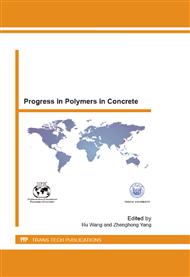p.274
p.282
p.291
p.298
p.303
p.311
p.316
p.322
p.329
Polymers for Concrete Modification – Interactions and Application Properties
Abstract:
Concrete is globally the most widely used construction material featuring outstanding properties as e.g. high mechanical strength, global availability, low cost and high durability if properly made. However, concrete exhibits also numerous intrinsic drawbacks as e.g. low tensile strength, poor elasticity, in many cases poor adhesion to various substrates and the formation of cracks and thus reduced durability. Many if not all of these drawbacks can be compensated by the addition of environmentally friendly water-based polymer dispersions. This article focuses on the fundamental understanding of the interaction of polymers with the other components in concrete, and its impact on the properties of latex-modified concrete (LMC), such as rheology, mechanical properties, adhesion, abrasion resistance etc. As a practical example the application of LMC in North American bridge deck overlays is discussed. Special attention is thereby paid to concrete mix designs, performance enhancement and the durability of these materials in the field.
Info:
Periodical:
Pages:
303-310
Citation:
Online since:
April 2013
Authors:
Keywords:
Price:
Сopyright:
© 2013 Trans Tech Publications Ltd. All Rights Reserved
Share:
Citation:


